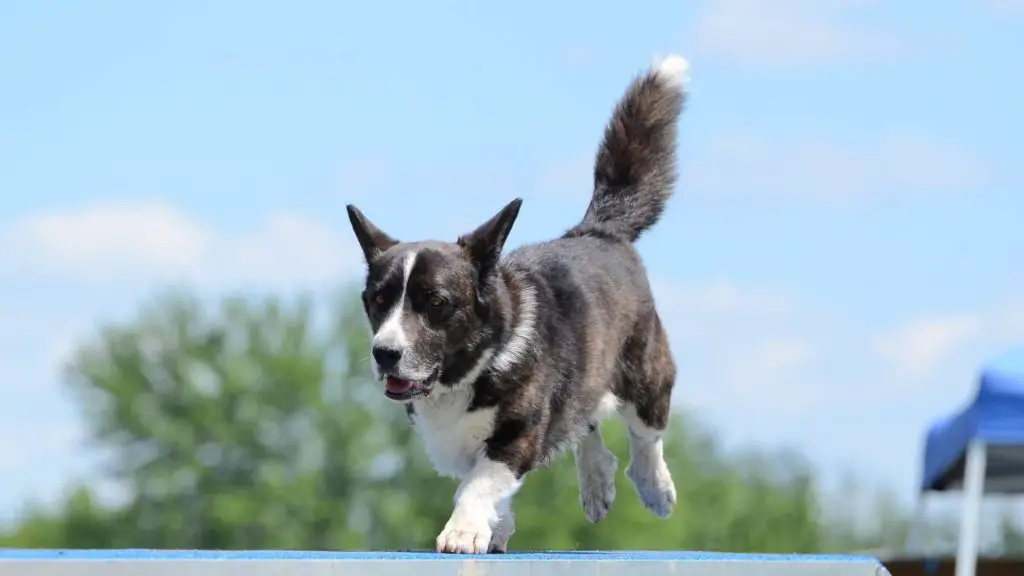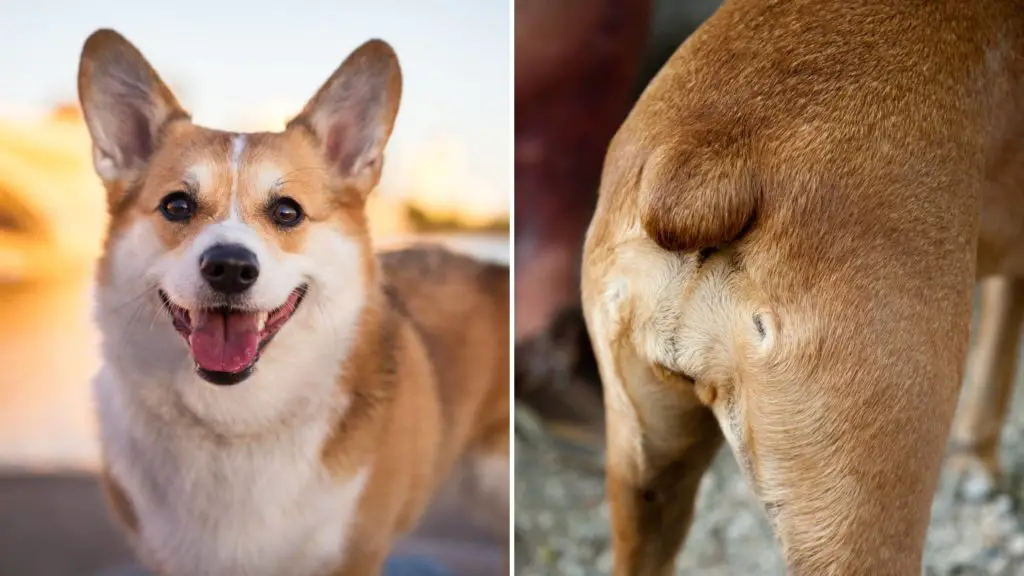Last Updated on 05/20/2021 by Veronica Jones
Corgis are a very popular dog breed, and they are Queen Elizabeth’s favorite kind of dog. Many people love them because they are cute, short and have a lot of personality. However, people may also notice that corgis do not always have the same kind of tail. Many people wonder why some corgis have long tails while others have little to no tail. Here is a complete guide to a corgi tail to help those who are curious.

The Corgi Tail
Corgi tails can be naturally short or long, but most corgis you might see today are short. Corgi tails can get docked to be short or almost nonexistent to fit the breed standard. A corgi can be born with a long or short tail, but it will depend on its genes.
Tail docking was a common historical practice for many dog breeds, including corgis. However, it is mainly done today for cosmetic purposes. In some cases, people do it for therapeutic reasons and to prevent injury. However, modern tail docking is only for aesthetic purposes. Many veterinarians urge pet owners and breeders not to dock dog tails because there is little proof that it will benefit dogs.

What Kind of Tails Do Corgis Have When They Are Born?
Most corgis have long, somewhat thick tails when they are born. It depends on what gene the puppy inherits, but many corgi pups will have nice long tails. However, it is possible for corgis to have short tails at birth, ranging from 1-2 inches long. The autosomal recessive gene (the long tail gene) only needs two copies of the mutant gene. Therefore, one or both parents that have the recessive gene can produce puppies with long tails.
The long tail gene is recessive, so it will always stay in the corgi gene pool. The short bobtail gene is an autosomal dominant gene, which means that a pair of autosomal chromosomes have one normal gene and one mutant gene. So, a puppy would only need one copy of the dominant bobtail gene to get a bobtail. However, if there are two copies of the dominant gene, there will be no puppy. Therefore, the recessive long tail gene will always be there.
So, there is no way to eliminate the long tail gene from corgis completely. A corgi puppy will not exist if the dominant gene is not present with the recessive gene. A puppy would either need one dominant gene and one recessive gene or two recessive genes. Moreover, some corgi owners may not know that their dog’s tails get docked because breeders dock tails shortly after birth.
Why Do Some Corgis Have Short Tails?
As mentioned earlier, some corgis can be born with short tails. All they need is one bobtail gene from one parent to get a short tail that can extend up to two inches long. However, a puppy cannot be born with two bobtail genes. Therefore, there is a 50/50 chance a corgi would be born with a bobtail. It is also possible for a corgi to have a short tail if its parents both have long tails. It would mean that one parent had a bobtail gene, and the puppy got it.

Why Do People Cut Off Corgi Tails?
Historically, people believed that tail docking was a good practice. People in the past thought that docking could prevent injuries when dogs are baiting, fighting and ratting. Moreover, past beliefs also stated that tail docking could make animals faster, make their backs stronger and prevent rabies. However, there is no proof that tail docking would support these past claims.
Currently, modern tail docking is done mostly for cosmetic purposes. It is the breed standard for a Pembroke Welsh Corgi to have a short tail. So, many breeders will try to meet that standard by docking the puppy’s tail. In some rare cases, a tail will get cut to prevent disease. For instance, if a tail gets a bad infection, the tail may get docked before it reaches the rest of the body.
Tail docking is often done on terrier dogs, herding dogs and hunting dogs in modern times. It is not necessary, but it can prevent infection and disease. The tails of these working dogs can collect foxtails and burrs that cause infection and pain. Moreover, a wagging tail can cause abrasion and other injuries when the dog goes through thickets and dense brush. It is also possible the tail can get easily injured while the dog works or makes the dog stuck underground (terrier dogs often go underground).

Tail docking may also be done for therapeutic reasons. Moreover, tail docking could also prevent injury. However, it will depend on the dog’s lifestyle, along with the owner and vet’s discretion. Additionally, tail docking will only prevent injury in rare cases, so it will not prevent injury altogether. Therefore, it is not an ideal practice to keep a corgi safe.
However, modern tail docking will primarily be for fitting the breed standard for corgis since there is little evidence that shows shorter tails are better. Kennel clubs and competition holders have very little forgiveness when it comes to undocked tails for certain breeds. Many of those people will not accept the dog as the “breed standard” if the tail is not docked. Kennel clubs say that practices like tail docking and ear cropping are good for dog’s health, but veterinarians and other animal organizations are highly against them.
What Is the Breed Standard for Corgis?
There are two kinds of corgis: the Pembroke Welsh corgi and the Cardigan Welsh Corgi. Most Cardigan Welsh corgis will keep their tails. However, the breed standard for Pembroke Welsh corgis is a docked tail. According to the breed standard, their tails should be extremely short with no indentation.
As mentioned earlier, some corgis can be born with a natural bobtail. Natural bobtail corgis will have a tail almost two inches long, which fits the breed standard. It is a tradition for the Pembroke Welsh corgi to get their tails docked, as it has been done for decades. So, it is common for many breeders to dock the puppy’s tail when it is young.
Typically, breeders and veterinarians will dock corgi tails 1-5 days after they are born. However, some veterinarians and breeders will dock tails without anesthesia when the puppies are 10-14 days old. Docking a tail when the puppy is older would likely be more troublesome for healing. Therefore, most breeders and vets will do it when they are very young.
Is It Cruel to Dock a Corgi’s Tail?
Overall, most studies show that docking a corgi’s tail is cruel. The main reason people do it is to reach the breed’s standard, so there will be no true benefit for the dog. Some people will “have to” dock a puppy’s tail if they want to enter them in professional contests. Some contests require show dogs to meet the breed’s standards, so a docked tail for a corgi will likely be required.
One study shows that tail docking could affect the way the dog communicates. Other dogs and people use a dog’s tail as visual cues to communicate since dogs cannot speak. The way the tail wags, twitches, hangs, etc., can signal different emotions in dogs. For instance, a wagging tail can show happiness and excitement, while a tail hidden between the hind legs can show fear. So, dogs with shorter tails would find it more difficult to communicate their feelings than those with longer tails.
Some researchers speculate that dogs with docked tails may grow up to be more aggressive. As stated above, a dog’s tail helps them communicate. If a dog is unable to show social cues, people and other dogs will approach docked dogs carefully because they do not know the docked dog’s emotional state. So, the docked dog may end up getting frustrated and grow up with angry and aggressive emotions.

Moreover, some dog breeds need their tails because they use them as rudders when they swim. For instance, Labradors have long, thick tails that help propel them through the water. So, docking their tail would make it more difficult for them to swim quickly. Additionally, docked tails tend to struggle more compared to undocked dogs when jumping and running. It is likely because they have to compensate for their lack of tail.
Most vets will state that tail docking is cruel. However, some vets may argue that docking tails to half the length would prevent injury and still allow communication in dogs. Overall, the vast majority of vets will be against tail docking. A lot of veterinary associations and groups urge breed organizations and competitions to remove tail docking from all of the breed standards to stop this practice.
Certain countries do not allow tail docking in show dogs. For instance, the United Kingdom does not require show dogs to have docked tails after 2007. Dogs with docked tails on or after the year are not allowed to be in competitions where viewers paid to watch the competitions. It does not matter where the tail gets docked because the UK will not allow them to be shown in those types of competitions. However, if the tail got docked to showcase the dog’s working ability and the public does not pay to watch, the docked tail will be allowed.
Does Tail Docking Hurt Puppies?

Yes, tail docking does hurt puppies. Some people may not think that it hurts puppies that much, but puppies do show signs of pain when their tails get docked. Puppies can feel pain at any age. Therefore, a puppy will not feel “less pain” if their tails get docked at an earlier age.
One study examined the behavior of 50 puppies from traditionally docked breeds. The researchers recorded the puppies’ behavior from the start of the procedure until the puppies went to sleep. All 50 puppies would cry during the procedure. The puppies would cry in pain when their tails got amputated, yelping about 24 times. However, there were no cries during the recovery period, but the process of docking is painful for puppies.
Many veterinarians are against tail docking because they believe it could cause long-term problems in the puppies. Veterinarians believe that pain in the puppy’s early development stages can cause lasting damage in the pups. Experiencing a lot of pain at a very early age could permanently change the central nervous system’s normal development. Therefore, there could be serious long-term issues caused by tail docking.
Should People Dock Corgi Tails?
No, most modern dog owners and dog breeders do not need to dock corgi tails. Most people dock dog tails at birth for purely aesthetic reasons. In rare cases, puppies may need to get their tails docked if there is something wrong with their tails at birth. Otherwise, tail docking is for aesthetic purposes. So, there is no real reason for healthy puppies to get their tails docked other than meeting the breed’s standards, which is not essential if the dog will not become a show dog.
As mentioned earlier, many people believe that modern tail docking can prevent injuries in working dog breeds. However, many veterinarians disagree with the practice of modern tail docking for working dogs. The largest study so far shows that only about 0.23% of dogs get tail injuries. Moreover, it is estimated that only 500 dogs would require tail docking, but that is only to prevent one tail injury.
So, most dogs will not need to get their tails docked. A tail might only have to get docked to meet the breed standard for some countries for show dog competitions. However, the average corgi that will simply be a regular pet will likely not benefit from tail docking.
To Conclude
Corgis can naturally have long or short tails at birth. However, many pet owners and breeders will dock corgi tails to make them short, mostly for aesthetic reasons. There is little evidence to prove that tail docking is beneficial for dogs. Therefore, corgis do not need to get their tails docked.
References:
- MedicineNet, ‘Medical Definition of Autosomal dominant’, https://www.medicinenet.com/autosomal_dominant/definition.htm, Accessed – 18 May 2021
- Wayback Machine, ‘Information on dog tail docking provided for the Animal Welfare Division’, https://web.archive.org/web/20070626075746/http://www.defra.gov.uk/animalh/welfare/domestic/awbillconsulttaildocking.pdf, Accessed – 18 May 2021

